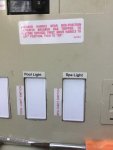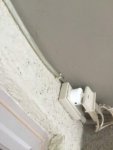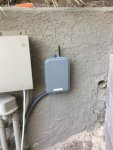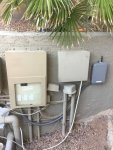- Jun 12, 2011
- 3,788
- Pool Size
- 19500
- Surface
- Plaster
- Chlorine
- Salt Water Generator
- SWG Type
- Pureline Crystal Pure 60,000
I just spent the last few days completing my Alexa controlled pool and patio system. I can now turn on or off all of the following devices, either by voice command using Alexa, or via an iPhone app from any location:
Spa pump
Heater
Spa light
Pool light
Patio light
Barbecue light.
The total cost of the project was just under $200 (including the Echo Dot to control it). It took me about two days to finish, although due to having to order and wait for some items, it was spread over a weeks time. Some basic electrical skills are needed, but nothing too complicated.
Due to the limited budget, I decided to forgo a WiFi hub based system. A hub system would provide better, and more dependable and robust coverage for the devices, albeit at a bit higher cost.
My system has standard deco type wall switches in my pool panel which operate the pool and spa lights.


Shopping for hubless standard 110 smart switches brings up a number to choose from, with an average price point right around $25 each. For no particular reason, I chose these:
Smart Switch by MartinJerry | Compatible with Alexa, Smart Home Devices Works with Google Home, No Hub required, Easy installation and App control as Smart Switch On/Off/Timing (2 Pack) - - Amazon.com
Since I was using that brand for wall switches, I elected to stay with the same brand (which also means using the same iPhone app) for my plug-in patio rope lights and barbecue lights.

https://www.amazon.com/gp/product/B0776WL59D/ref=oh_aui_detailpage_o05_s01?ie=UTF8&psc=1
With the lighting sorted out, I turned my attention to control of my attached spa. The pump and heater were both wired on a single 220 circuit. I always thought that was a problem since the heater should be turned off before the pump shuts down. In the past that was impossible without a trip to the heater to manually shut it off. I decided that the heater should be on a separate switch, but wired so that the pump must be on for the switch to be active. Being a cheapskate, I decided on re wiring the heater to 110 operation and just adding a third 110v smart switch. I could have left it 220 but that would require a second 220 switch. Re wiring was not a big problem, the manual for the heater had wiring instructions for 220 or 110v. I just pulled the power from one leg of the 220v circuit I would later run to the pump.
Control of the spa pump itself required a 220v DPST smart switch. There seem to be very limited choices in this area. The only hubless 220 switch that I could find that met my needs and my limited budget was this:
https://www.amazon.com/gp/product/B00ZYLTJ16/ref=oh_aui_detailpage_o04_s01?ie=UTF8&psc=1
I had to add one of these:
https://www.amazon.com/gp/product/B0756N989G/ref=oh_aui_detailpage_o04_s00?ie=UTF8&psc=1
plus some additional items from the local hardware store to mount and connect the WiOn 220v control box.

Since the WiOn 220v control and the smart switches use different iPhone apps, it took a bit to get everything online and then to connect it with Alexa Smart Home.
It was all working, but I found that using a hubless system put a bit of strain on the limits of my home WiFi system. Rather than invest in a range booster or a more robust router, I decided to try a more economical approach (did I mention, I’m cheap?) . Since the system seemed very dependable when I was working on it, with the metal door on the panel open, I thought of an alternate approach. For $10, I purchased a 12x12 piece of lexan! Then cut a 10x10 opening in the door immediately above the switches and installed the lexan window.

The WiFi switches now seem very dependable and it all works.
I even grouped all the lights under the command “Patio”
So, now Alexa can be told to turn on (or off)
The Booster Pump
The Heater
The Pool Light
The Spa Light
The Rope Lights
The Barbecue Light
or, I can say “turn on the Patio Lights”, which is all the lights.
Actual total cost for the project was $191.24. And about two days work.
If anyone wants to do something similar and has any questions, just post them or PM me.
UPDATE - due to price reductions, this project could be now be completed for less than $150!
The 220v switch I used is no longer available, same switch now under different listing.
Spa pump
Heater
Spa light
Pool light
Patio light
Barbecue light.
The total cost of the project was just under $200 (including the Echo Dot to control it). It took me about two days to finish, although due to having to order and wait for some items, it was spread over a weeks time. Some basic electrical skills are needed, but nothing too complicated.
Due to the limited budget, I decided to forgo a WiFi hub based system. A hub system would provide better, and more dependable and robust coverage for the devices, albeit at a bit higher cost.
My system has standard deco type wall switches in my pool panel which operate the pool and spa lights.


Shopping for hubless standard 110 smart switches brings up a number to choose from, with an average price point right around $25 each. For no particular reason, I chose these:
Smart Switch by MartinJerry | Compatible with Alexa, Smart Home Devices Works with Google Home, No Hub required, Easy installation and App control as Smart Switch On/Off/Timing (2 Pack) - - Amazon.com
Since I was using that brand for wall switches, I elected to stay with the same brand (which also means using the same iPhone app) for my plug-in patio rope lights and barbecue lights.

https://www.amazon.com/gp/product/B0776WL59D/ref=oh_aui_detailpage_o05_s01?ie=UTF8&psc=1
With the lighting sorted out, I turned my attention to control of my attached spa. The pump and heater were both wired on a single 220 circuit. I always thought that was a problem since the heater should be turned off before the pump shuts down. In the past that was impossible without a trip to the heater to manually shut it off. I decided that the heater should be on a separate switch, but wired so that the pump must be on for the switch to be active. Being a cheapskate, I decided on re wiring the heater to 110 operation and just adding a third 110v smart switch. I could have left it 220 but that would require a second 220 switch. Re wiring was not a big problem, the manual for the heater had wiring instructions for 220 or 110v. I just pulled the power from one leg of the 220v circuit I would later run to the pump.
Control of the spa pump itself required a 220v DPST smart switch. There seem to be very limited choices in this area. The only hubless 220 switch that I could find that met my needs and my limited budget was this:
https://www.amazon.com/gp/product/B00ZYLTJ16/ref=oh_aui_detailpage_o04_s01?ie=UTF8&psc=1
I had to add one of these:
https://www.amazon.com/gp/product/B0756N989G/ref=oh_aui_detailpage_o04_s00?ie=UTF8&psc=1
plus some additional items from the local hardware store to mount and connect the WiOn 220v control box.

Since the WiOn 220v control and the smart switches use different iPhone apps, it took a bit to get everything online and then to connect it with Alexa Smart Home.
It was all working, but I found that using a hubless system put a bit of strain on the limits of my home WiFi system. Rather than invest in a range booster or a more robust router, I decided to try a more economical approach (did I mention, I’m cheap?) . Since the system seemed very dependable when I was working on it, with the metal door on the panel open, I thought of an alternate approach. For $10, I purchased a 12x12 piece of lexan! Then cut a 10x10 opening in the door immediately above the switches and installed the lexan window.

The WiFi switches now seem very dependable and it all works.
I even grouped all the lights under the command “Patio”
So, now Alexa can be told to turn on (or off)
The Booster Pump
The Heater
The Pool Light
The Spa Light
The Rope Lights
The Barbecue Light
or, I can say “turn on the Patio Lights”, which is all the lights.
Actual total cost for the project was $191.24. And about two days work.
If anyone wants to do something similar and has any questions, just post them or PM me.
UPDATE - due to price reductions, this project could be now be completed for less than $150!
The 220v switch I used is no longer available, same switch now under different listing.
DEWENWILS Outdoor Smart Wi-Fi Outlet Box, Heavy Duty 40A 120VAC 2HP Wireless Controller Timer Switch for Pool Water Heater SPA, Compatible with Smart Phone, Alexa, UL Listed - - Amazon.com
DEWENWILS Outdoor Smart Wi-Fi Outlet Box, Heavy Duty 40A 120VAC 2HP Wireless Controller Timer Switch for Pool Water Heater SPA, Compatible with Smart Phone, Alexa, UL Listed - - Amazon.com
www.amazon.com
Last edited:

